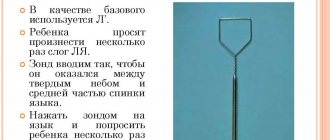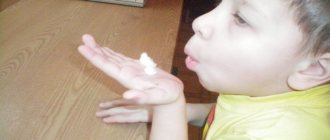Pronunciation of the T sound
We can highlight common mistakes made in the pronunciation of the T sound:
- replacing the sound T (it is front-lingual) with G and K (they are called back-lingual);
- mixing or rearranging consonants located next to the sound T (“rolled” instead of “glass”);
- after P or K, the T sound is lost and replaced with a softening (“piichka” instead of “birdie”);
- replacing the sounds Ch and C with T (“nine” instead of “girl”, “Petsya” instead of “Petya”).
Children who replace the T sound with some other sound often have incorrect articulation. The child raises his tongue to the palate, while the tip of the tongue should rest against the front teeth.
The reasons for incorrect pronunciation are as follows:
- malfunctions of the articulatory apparatus (speech organs);
- the lower jaw is weakly developed, which is why it is inactive during speech;
- the hearing organs are poorly developed, which is why the child cannot distinguish sounds by ear;
- imitating an adult who has problems with correct pronunciation.
Only a speech therapist can make a diagnosis. And parents, in turn, can practice at home the exercises recommended by a professional.
Articulation of the sound G
Mastering any speech sound is a gradual process. First, isolated pronunciation is developed, it is clarified and stated. And parents are unlikely to be able to help their child if they themselves do not know how a particular sound is formed.
IMPORTANT! Age-related difficulties with the pronunciation of the posterior palatal (rear lingual) consonant sounds G, K and X are in many ways natural. Even just activating the root of the tongue and coordinating its interaction with the back of the palate can be difficult for a baby. Indeed, outside of speech activity, muscle motility in this part of the oral cavity is mainly of a reflex nature and does not require conscious control.
Articulation is the control of the conditions necessary to pronounce a sound. In the process of automation, stable patterns of interaction between parts of the speech apparatus are developed. This relieves the speaker of the need to constantly monitor the articulation process; it is actually programmed.
In the “Broca's area” of the cerebral cortex, commands are given, after which the necessary conditions for pronouncing a specific sound in a specific position are reproduced automatically.
This concerns not only the “obstacles” in the mouth and the general configuration of the oral cavity, but also the characteristics of the air stream, as well as the condition of the vocal cords, which are used to form vowels and voiced consonants.
Now specifically about the sound G. The previous stage in its production should be mastering the sound K, since from the point of view of articulation they are very close:
- lips and teeth are open and in a neutral position;
- the tip of the tongue lies and does not touch the lower incisors;
- the back of the tongue meets the palate;
- the lateral edges of the tongue touch the upper molars;
- The soft palate is raised and pressed against the back wall of the nasopharynx.
The difference lies in the participation of the voice and the characteristics of exhalation. In addition to the above conditions, when pronouncing the sound G:
- the ligaments close and vibrate;
- the air stream does not have such an impulsive and explosive character.
Features of articulation G' (soft sound):
- the back of the tongue is sharply curved in the middle part and touches the hard palate;
- the tip of the tongue approaches the lower incisors;
- the corners of the mouth are pulled back;
- lips press against incisors.
IMPORTANT! Articulation of the G sound in conjunction with other subsequent sounds is a little more difficult than its own sound, but isolated. Any sound following G determines what shape the lips take, and vowels additionally affect the distance between the incisors.
Possible deviations and disorders for which it is strongly recommended to consult a speech therapist:
- noticeable distortion of the G sound or its absence (gammatism);
- replacing the sound G with another consonant - K, D and the corresponding soft ones (paragammatism).
The causes of gammatism and paragammatism can be both insufficient development of the muscles of the tongue and congenital structural features of the palate. Sometimes behind these speech defects there are pathologies of phonemic (sound recognition) and physical hearing or a violation of the innervation of the language. Thus, these speech defects cannot be left unattended. Along with a speech therapist, the problem may fall within the competence of a pediatrician or neurologist, as well as other medical specialists.
Articulatory gymnastics for the sound t
It is necessary to do articulation exercises daily. Get used to the fact that in any free time you and your baby develop the speech apparatus.
More on the topic:
- Articulatory gymnastics for the sound Ш
- Exercises for sounds “S, C, Z”
Setting the T sound
- Choose several syllables or words that contain the letter combination TA, and repeat them at least 10 times.
- Place the tongue between the teeth and press it firmly, but at the same time so that it does not hurt the baby, with the jaw. Take a deep breath and, as you exhale, say an interdental T.
- Place your tongue between your teeth again. Stretch your teeth in a smile and “spit.” After this, give your jaw a rest.
- T is a derivative sound from P. Therefore, you can start warming up by practicing the sound P. Say Pa-Pa several times, while the wide part of the tongue should be pressed to the lower lip. Gradually stretch your lips into a smile and move on to pronouncing Ta-Ta.
- Place the tongue between the teeth. Say Pa-Pa again several times. At this moment, the adult spreads the child’s lips with his index finger and thumb. When the manipulation is performed correctly, Ta-Ta is pronounced.
Speech therapy massage for children
Sound production
- Talk to the child Ta-Ta.
- A special paddle is used to soften the sound. Use it to press the tip of your tongue and lower it down. You should get the letter combination Tya.
- The sound Th is produced by clicking the tip of the tongue; the teeth should be closed at this time.
- You can complicate the exercise: do not press your tongue against the palate, but stick it out.
Sonora
This group includes “L”, “R” and their soft pairs. It is advisable to begin the correction with them, simultaneously working on the preparatory stage for the hissing ones. Often they are quickly processed.
There are three ways to set sound:
- mechanical - it requires probes or their substitutes;
- by imitation - not always possible;
- mixed - implies the use of both.
Producing the sound “R” with dysarthria is better done with a probe. Due to problems with the motor muscles, it will not be possible to call him by imitation. The probe looks like a smooth stick with a small ball at the end.
It is better to place the child on his back. He should relax. He is asked to open his mouth, place the tip of his tongue on the alveoli and pronounce the distorted sound “Z” (provided that it is in speech). At this moment, the tongue is gently swung with a probe.
With fast movements, a proper roar will be heard. Focus the preschooler's attention on this moment. Unlike other sounds, automation can begin with mechanical assistance. To do this, it is better to use combinations of syllables with “TR” and “DR”.
Gradually, unnoticed by the child, the probe moves away, and the preschooler begins to growl correctly. After syllables, words are used and the last stage is tongue twisters and stories.
The “L” sound is best placed interdentally. To do this, the child is asked to lightly bite the tip of his tongue and pronounce the sound “Y”. This exercise is called the “steamboat whistle”.
After this stage can be reproduced well, you need to remove the tongue behind the teeth.
This requires a little trick. The preschooler is asked to imagine that the tongue is a mouse. To hide it, you need to quickly remove the tip after the beep. In this case, it will automatically strike the alveoli and the correct “L” sound will be heard.
Automation happens the same way. First, they use forward and backward syllables, then words, then tongue twisters.
In order to make this process interesting, different games are used. For example, to automate syllables, they suggest imagining that the room is a swamp. To move, you need to jump over bumps and pronounce syllables.
Or they use a variety of walking board games. The marbles are laid out in circles, passed through with your fingers, etc.
Speech therapy exercises
It is necessary to work on overall articulation and clarity of speech. For this, simple and interesting speech therapy complexes are used. We present one of these to your attention.
- “Brushing our teeth.” Stretch your lips in a smile, mouth slightly open. Use your tongue to walk alternately over the upper and lower teeth from the back side. Move from left to right and then in the opposite direction.
- "Spatula". Smile again with your mouth slightly open. Place the wide part of your tongue on your lower lip. Stay in this position for 10 seconds. You can start with 5 seconds.
- “Tube”. Extend your tongue as much as possible and tense it. Then, if possible, roll it up into a tube and stay in this position for 5-10 seconds.
- "Swing". Open your mouth slightly and press the wide part of your tongue against your lower teeth. Then raise your tongue to your upper teeth. We linger in each position for 2-3 seconds. In this case, you need to press with maximum force.
- "Slide". Starting position – mouth slightly open. Press the tip of your tongue firmly against the bottom row of teeth. Then, without lifting the tip, press with the wide part of your tongue (it should bend as if). Stay in this position for 5 seconds.
- "Mountain Wind" Place your tongue in the position described in the previous exercise and blow as hard as possible. In this case, the entire speech apparatus should be tense.
Setting the sound t when replacing with k
- First you need to teach your baby to distinguish between these two sounds. To do this, you can give pictures, the images in which begin with the sounds T or K, and also pronounce such words out loud. Ask the child to distribute into groups (K and T).
- Game “Catch the Sound”. The adult pronounces a small series of letter combinations, and the child must clap his hands when he hears the given sound.
- We are looking for the sound K. Dar-ra-ko-so. Sa-lo-ku-we. Am-da-ka-he ku-ro-lo-ky
- We are looking for the sound T. Ba-ta-do. Na-la-to. Ash-bo-ot. Ju-fu-fu.
Methods of speech therapy examination of children according to Akimenko V.M.
Automation of the G sound in pure tongues
Pure sayings are easy-to-remember comic similarities to nursery rhymes or counting rhymes that are well suited for the role of exercises. Pure tongues begin with the repetition of several syllables, where attention is focused on the sound being reinforced.
Composing phrases yourself is a good way for parents to creatively approach the development of their child’s speech. It's better if they make at least a little sense. Here are some examples.
- Ha-ha-ga, ha-ha-ha, - the geese go to the meadows.
- Oh-ho-ho, oh-ho-ho! - There is nothing in the cave.
- Goo-goo-goo, goo-goo-goo, - the owl is hiding in a haystack.
- E-ge-ge, e-ge-ge! - we are running along the rainbow.
- Gi-gi-gi, gi-gi-gi, they call us for pies.
Finally
G is just one of the speech sounds. And it’s far from the only one that causes difficulties for young children. When working with a child, we must remember that an adult’s speech must be clearly intonated, and the external features of articulation must be clearly distinguishable.
You should not repeat defective scale patterns after your child. It is useful to show examples of correct speech several times. It is recommended to stimulate the child’s speech with questions.
Related posts:
- Rhoticism in speech - complete information Rhotacism (problem with the sound [P]) is the most common disorder in children...
- The sound “Zh” - from production to automation Automation of the sound “Zh” begins with identifying the reasons that interfere with the correct sound pronunciation...
- A child does not know how to say R - we’ll show you how to teach it. To teach a child to pronounce the letter R, you need to regularly perform special...
- Signs of glasnost in the Russian language All speech sounds are divided into vowels and consonants, between them...
Setting the t sound for dysarthria
At the very beginning, you need to pay attention to warming up the tongue and removing tone, as well as general gymnastics for the speech apparatus. For this purpose, the speech therapy exercises listed above are used.
- Raise and lower your tongue, turn right and left. In this case, the tongue is extended as much as possible.
- Then the adult invites the child to tap his tongue on the upper palate (the sound should be T).
- To obtain a soft consonant, the tongue is pressed harder against the palate and moves out more between the teeth. At the same time, the passage for air is reduced.
- To practice the T sound, it is pronounced between two vowels (at least 10 repetitions).
- The baby must cluck at least 20 times. After this, the task becomes more complicated: you need to click while exhaling, not while inhaling.
- The child is asked to place his palm on his larynx. After this, pronounce the sounds T and D. Focus on the difference in vibrations during the pronunciation of the sounds T and D.











